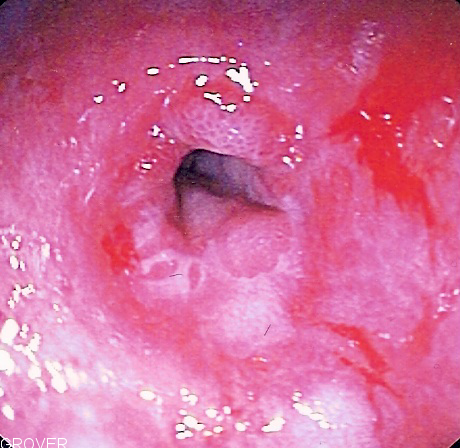Esophageal stricture: Difference between revisions
Jump to navigation
Jump to search
No edit summary |
m (Bot: Removing from Primary care) |
||
| (2 intermediate revisions by one other user not shown) | |||
| Line 15: | Line 15: | ||
'''For patient information, click [[Esophageal stricture (patient information)|here]]''' | '''For patient information, click [[Esophageal stricture (patient information)|here]]''' | ||
{{CMG}}; {{AE}}{{MA}} | {{CMG}}; {{AE}}{{MA}} | ||
==[[Esophageal stricture overview|Overview]]== | ==[[Esophageal stricture overview|Overview]]== | ||
==[[Esophageal stricture historical perspective|Historical Perspective]]== | ==[[Esophageal stricture historical perspective|Historical Perspective]]== | ||
==[[Esophageal stricture classification|Classification]]== | ==[[Esophageal stricture classification|Classification]]== | ||
==[[Esophageal stricture pathophysiology|Pathophysiology]]== | ==[[Esophageal stricture pathophysiology|Pathophysiology]]== | ||
==[[Esophageal stricture causes|Causes]]== | ==[[Esophageal stricture causes|Causes]]== | ||
==[[Esophageal stricture differential diagnosis|Differentiating Esophageal stricture from other Disorders]]== | ==[[Esophageal stricture differential diagnosis|Differentiating Esophageal stricture from other Disorders]]== | ||
==[[Esophageal stricture epidemiology and demographics|Epidemiology and Demographics]]== | ==[[Esophageal stricture epidemiology and demographics|Epidemiology and Demographics]]== | ||
==[[Esophageal stricture risk factors|Risk Factors]]== | ==[[Esophageal stricture risk factors|Risk Factors]]== | ||
==[[Esophageal stricture natural history, complications and prognosis|Natural History, Complications, and Prognosis]]== | ==[[Esophageal stricture natural history, complications and prognosis|Natural History, Complications, and Prognosis]]== | ||
==Diagnosis== | ==Diagnosis== | ||
| Line 58: | Line 49: | ||
* [[Esophageal cancer]] | * [[Esophageal cancer]] | ||
* [[Esophagitis]] | * [[Esophagitis]] | ||
{{WikiDoc Help Menu}} | |||
{{WikiDoc Sources}} | |||
[[Category:Gastroenterology]] | [[Category:Gastroenterology]] | ||
[[Category:Medicine]] | [[Category:Medicine]] | ||
[[Category:Up-To-Date]] | [[Category:Up-To-Date]] | ||
Latest revision as of 21:40, 29 July 2020
| Esophageal stricture | |
 | |
|---|---|
| Endoscopic image of a benign peptic stricture | |
| ICD-9 | 530.3 |
| DiseasesDB | 31502 |
| MedlinePlus | 000207 |
|
Esophageal stricture Microchapters |
|
Diagnosis |
|---|
|
Treatment |
|
Surgery |
|
Case Studies |
|
Esophageal stricture On the Web |
|
American Roentgen Ray Society Images of Esophageal stricture |
For patient information, click here
Editor-In-Chief: C. Michael Gibson, M.S., M.D. [1]; Associate Editor(s)-in-Chief: Mahda Alihashemi M.D. [2]
Overview
Historical Perspective
Classification
Pathophysiology
Causes
Differentiating Esophageal stricture from other Disorders
Epidemiology and Demographics
Risk Factors
Natural History, Complications, and Prognosis
Diagnosis
Diagnostic Study of Choice | History and Symptoms | Physical Examination | Laboratory Findings | Electrocardiogram | X Rays | CT | MRI | Echocardiography or Ultrasound | Other Imaging Findings | Other Diagnostic Studies
Treatment
Medical Therapy | Surgical | Primary Prevention | Secondary Prevention | Cost-Effectiveness of Therapy | Future or Investigational Therapies